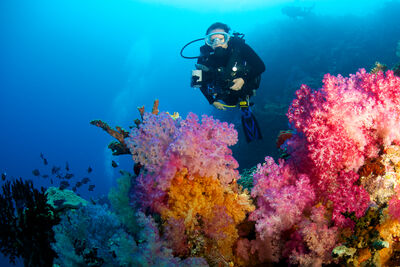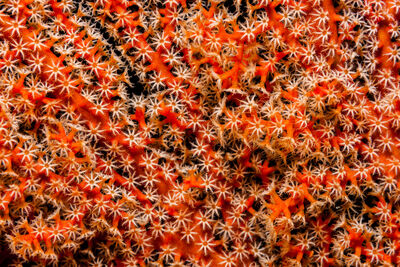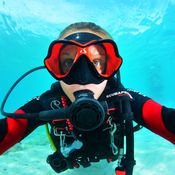From long, wispy strands of sea whip coral to coral-encrusted walls, and from shallow patches of lettuce leaf corals to the bulbous grooved brain coral, coral reefs are the pièce de résistance for many divers. After all, these underwater cities offer some of the best animal viewing on the planet; the Coral Triangle alone supports over 6,000 species of fish. So, whether you're planning your next holiday around coral diving or want to brush up on coral facts for the next (very niche) pub quiz, here are ten fascinating facts about these incredible animals...

Corals Are Animals
Putting Chelsea Flower Show to shame, there is nothing quite like seeing the technicolour shades of coral reefs. Yet despite creating beautiful gardens, corals are not plants but formed by tiny animals called polyps. The cousin to sea anemones and jellyfish - classified as Cnidarians - coral polyps will grow and divide to form large colonies which eventually develop into the reefs we see today. Some date as far back as 50 million years!
Corals Wear Sunscreen
One of our favourite coral facts: like humans, corals require sun protection. These sun-savvy creatures naturally generate fluorescent pigments which serve as a shield against ultraviolet light by absorbing harmful wavelengths, acting akin to sunscreen. These pigments induce a neon glow in select corals, and scientists posit that this phenomenon safeguards the single-celled organisms residing within them, known as zooxanthellae.

Some Corals are Carnivores
For coral, teamwork makes the dream work, especially when it comes to food. Corals have a symbiotic relationship with an algae called zooxanthellae which supply nutrients for the coral by photosynthesis. In return, the zooxanthellae get shelter and a place to grow. However, some corals favour a more carnivorous diet. These corals have stinging cells and barbs, which they use to harpoon or sting their prey of plankton and small fish.
Some Corals Are Broadcast Spawners
Like the birds and the bees, corals can reproduce sexually. One such way is through mass coral spawning, where corals release their eggs and sperm at the same time to be fertilized, usually after a full moon. Divers lucky enough to catch a coral spawning - two top spots being Grand Cayman and Bonaire - will see tiny dots rising off a coral reef in a cloud. Once fertilized, these coral larvae then ride the ocean currents in search of a suitable home. Once they find a suitable spot, they attach themselves to the seabed, eventually developing into a coral polyp and then a colony.

Corals Can Reproduce Asexually
Corals can also reproduce asexually by budding or fragmentation. You may have taken part in, or heard of, coral fragging, which involves humans taking fragments of smaller corals from a larger colony and replanting the small fragments on different sections of reef. Corals are no different, as coral polyps will break off their parent to form new colonies. These colonies will share the same genetics as the original colony.
Corals Like Sunlight, but Not Too Much
While coral relies on sunlight for nutrients, too much can be detrimental. If the ocean gets too warm, corals will expel their zooxanthellae as a defence mechanism; this produces the ghostly white skeleton you see during coral bleaching. If temperatures return to normal within a short period, corals have the ability to reverse the effects of coral bleaching by re-absorbing the zooxanthellae.

Corals Can Be Found in Warm and Cold Water
While the most famous coral reefs are found in tropical waters, these colourful creatures also thrive in colder, deeper water. However, unlike tropical corals, cold-water corals do not absorb zooxanthellae, and instead rely solely on food particles - floating in the water column - for their source of food and energy. In fact, corals have been found as deep as 2,000 metres and in temperatures as low as 4oC.
Corals Outlived Dinosaurs
Scientists are now using a genetic approach to find the age of corals. The method determines where a coral sperm and egg originally met and records the preceding mutations. While most range between 5,000 - 10,000 years, larger reefs - fringing, barrier and atolls - can take up to 300,000 years to form. Fossils have also been found dating back 160 million years, around the same time as dinosaurs.

There are Over 6,000 Species of Coral
Corals come in all shapes and sizes. Some are hard corals - like staghorn or elkhorn coral - and make up 40% of the world's coral species. The remaining 60% are soft corals, like zoanthids or finger leather coral. The majority of coral species can be found in the Pacific Ocean, compared to about 65 species found in the Caribbean. Now you know why we are always harping on about diving in Indo-Pacific destinations like Papua New Guinea, Fiji and Indonesia!
Corals are Ecosystem Engineers
Despite occupying less than 1% of the ocean floor, coral reefs are the most biodiverse ecosystems on the planet. From pygmy seahorses wrapped around gorgonians to patrolling reef sharks, coral reefs support 25% of all marine life. These systems are also vital to supporting us landlubbers, as corals protect our coasts from up to 90% of potentially damaging waves and flooding.
If these coral facts have inspired you to explore the oceans coral cities, get in touch with our diving experts and start planning your next diving adventure.












